High-Quality Reclaimed Wood: Unveiling the Beauty and Benefits of Time-Worn Lumber

Introduction: The Allure of Reclaimed Wood
High-quality reclaimed wood has garnered significant attention in recent years, as homeowners, builders, and architects alike have come to appreciate the unique characteristics and eco-friendly nature of this versatile building material. This article will delve into the world of high-quality reclaimed wood, exploring its history, benefits, and various applications, as well as offering tips for selecting and incorporating it into your projects.
Origins: Unearthing the Roots of Reclaimed Lumber
A Historical Perspective
High-quality reclaimed wood refers to timbers and lumber that have been salvaged from older structures, such as barns, factories, and warehouses. This practice dates back centuries, with evidence suggesting that ancient Romans and Egyptians reused timbers from older buildings to construct new ones.
graph LR
A[Ancient Romans] -->|Reused Timbers| B[New Structures]
C[Ancient Egyptians] -->|Reused Timbers| B[New Structures]
The Sources of Reclaimed Wood
Reclaimed wood can be obtained from various sources, including:
- Demolished structures: Old buildings, barns, and warehouses are prime sources of reclaimed wood, providing a treasure trove of unique and character-rich materials.
- Water-recovered lumber: Logs and timbers submerged in rivers and lakes for decades, or even centuries, can be salvaged and repurposed, offering remarkable durability and unique patinas.
- Industrial byproducts: Remnants from manufacturing processes, such as wooden crates, pallets, and wine barrels, can be upcycled into one-of-a-kind building materials.
Benefits: Uncovering the Advantages
Environmental Sustainability
Reusing and repurposing wood reduces the need for new lumber, therefore conserving natural resources and protecting forests. Additionally, reclaimed wood often requires less energy for processing and transportation, thereby reducing the carbon footprint of construction projects.
Durability and Stability
Due to its age, reclaimed wood has had ample time to dry and harden. As a result, it increased strength and stability compared to newly harvested lumber. This makes it ideal for various applications, including flooring, cabinetry, and furniture.
Unique Aesthetic Appeal
The rich patina, intricate grain patterns, and nail holes of reclaimed wood tell a story that new lumber simply cannot replicate. These unique characteristics make reclaimed wood an attractive choice for those seeking to add warmth, character, and a touch of history to their spaces.
Applications: The Many Faces of Reclaimed Wood
Flooring
Reclaimed wood flooring offers unparalleled durability, beauty, and charm. Available in various species, widths, and finishes, it can be tailored to suit any design style, from rustic to contemporary.
Furniture
From dining tables and bookshelves to bed frames and coffee tables, reclaimed wood furniture can be a stunning focal point in any room, showcasing its natural beauty and adding warmth and personality to the space.
Architectural Elements
Reclaimed wood beams, mantels, and doors can lend a sense of history and character to any building, while reclaimed wood paneling and wainscoting can add visual interest and texture to walls.
Tips for Selecting and Incorporating Reclaimed Wood
Know the Source
When purchasing reclaimed wood, ensure that it comes from a reputable supplier who can provide information about the wood’s history and origin.
Consider the Application
Be mindful of the intended use for the reclaimed wood, and select a species and grade suitable for that purpose. For instance, high-grade woods are better suited for flooring and furniture, while low-grade woods are more appropriate for decorative applications.
Ensure Proper Treatment
Before using reclaimed wood in your project, ensure that it has been properly treated to remove any insects, mold, or other contaminants. A reputable supplier will typically kiln-dry the wood and treat it with non-toxic chemicals to ensure its safety and longevity.
Embrace the Imperfections
Part of the appeal of reclaimed wood is its inherent imperfections, such as nail holes, knots, and weathered surfaces. Rather than trying to hide these elements, embrace them as part of the wood’s unique charm and character.
Mix and Match
Don’t be afraid to mix high-quality reclaimed wood with other materials or finishes. Combining reclaimed wood with metals, glass, or other textures can create an eclectic, layered look. That also adds depth and visual interest to your space.
Maintenance and Care
Cleaning and Maintenance
To maintain the beauty of high-quality reclaimed wood, clean it regularly with a soft, dry cloth to remove dust and debris. If necessary, use a damp cloth and mild detergent to tackle more stubborn dirt or stains. Avoid using harsh chemicals or abrasive cleaning tools, as they may damage the wood’s surface.
Protecting the Surface
To preserve the finish and prevent damage, apply a sealant or protective coating to high-quality reclaimed wood surfaces. For eg: floors, countertops, furniture, etc. Be sure to follow the manufacturer’s recommendations for the type of finish and frequency of application.
Repair and Restoration
In the event of damage to your reclaimed wood, consult a professional for advice on repairs and restoration. With proper care and attention, high-quality reclaimed wood can be a long-lasting and beautiful addition to your home or commercial space.
Conclusion:
High-quality reclaimed wood offers a unique combination of history, character, and eco-friendly benefits. As it makes it an ideal choice for a wide range of applications. By understanding its origins, advantages, and proper care, you can incorporate this time-worn material into your projects with confidence. It creates spaces that are both visually stunning and environmentally responsible. Embrace the beauty of reclaimed wood and let its story become a part of your own.
